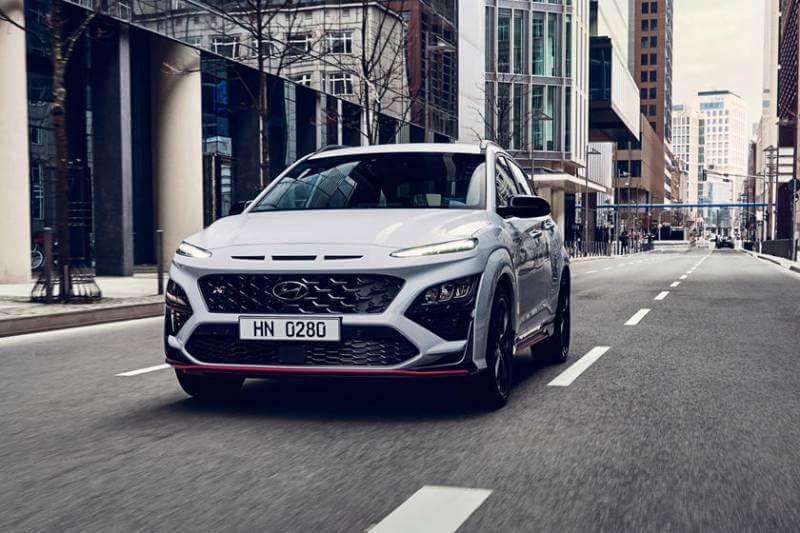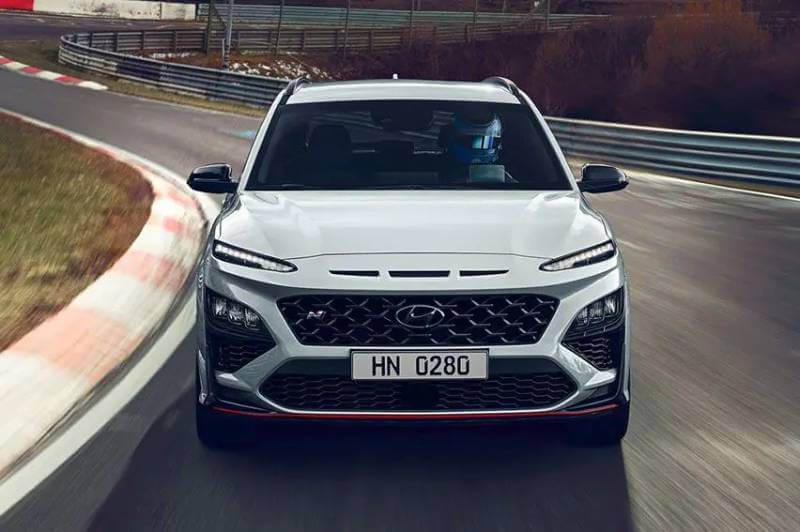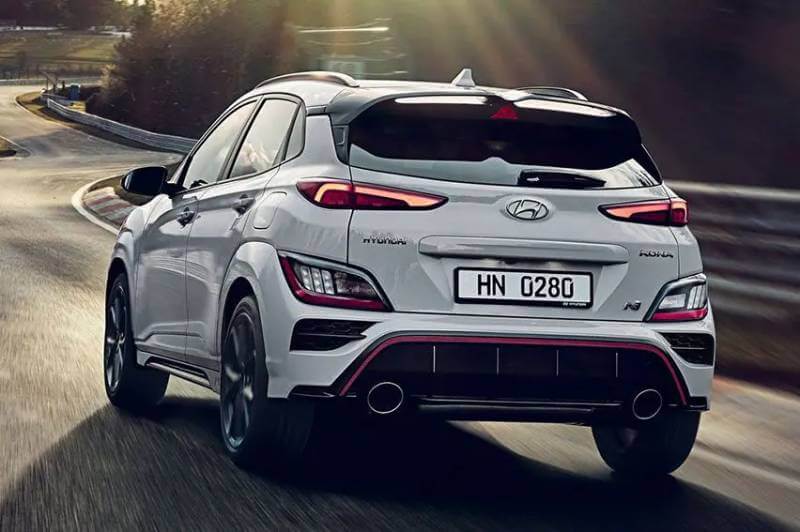Hyundai has finally introduced a new model. Not only as a new model but also the fastest SUV from the Hyundai lineup; Kona N. Long speculation accompanied the birth of the Hyundai Kona N. Starting from rumors during the development period to the leaked photos everywhere. The hot SUV finally introduced his true identity. At the same time inaugurating the first SUV in the pure N family line. Without a doubt challenging two species at once. High-performance hot hatch and crossover clans.

N’s philosophy is so inherent even though Kona is not an ideal figure to create a racing aura. That’s why the development process is taking a long time. The Nürburgring Nordschleife sacred circuit is proof that the N division team is working hard to create the most ideal car. Agile as a hot hatch but also versatile as an SUV. That’s the promise of the manufacturer, creating the best combination of versatility, acceleration, agility and being ready to take the track anywhere.
Hyundai N is still in the growth stage. The model continues to be enriched and is now being added by Kona. After first filling in the i20 N, i30 N and Veloster N, there will also be the arrival of Elantra N. As a bridge with a regular model, Hyundai is also preparing the N Line variant as well. As if imitating the BMW M Sport and Mercedes-AMG Line. No problem, indicating seriousness in fulfilling the desires of consumers who do not want monotonous sensations.

“Our growing and more balanced N portfolio will open up new high-performance options, providing the ‘smile factor’ no matter what propulsion technology or body type,” explained Thomas Schemera, Executive Vice President and head of customer experience division at Hyundai.
Meanwhile, Albert Biermann as president and head of R&D Hyundai shared, “The Kona N is a really hot SUV with a performance level like a hot hatch. This breaks the rule that SUVs are less fun to drive. As an N model, it goes beyond the limits of an ordinary SUV. Kona N can carve corners on the racetrack and bring joy to everyday riding. “

Kona N was not designed carelessly. The main attention is on the T-GDI pacemaker, which was first used by the Veloster N. The 4-cylinder 2.0-liter turbocharger unit promises fierce torque at low speed, minimal lag and raucous, intimidating screams. Power extraction generates 276 hp (280 PS) and whips up 392 Nm of torque. Power is channeled to the front wheels via an 8-speed N DCT transmission adopted from the i30 N using a wet type is not without reason. He said it is better in the cooling process and faster to accelerate and shift gears.
Unfortunately it is only offered in that type of gearbox. Conservative consumers will bite their fingers without the presence of a manual version. Likewise, those expecting all-wheel drive (AWD) should be disappointed. Instead, Hyundai offers an electric game that gives a video game-like sensation. There is a boosting system in the form of additional power to 286 hp (290 PS) via the N Grin Shift (NGS) button. Only 20 seconds out, perfect for early acceleration or overtaking other cars. Claim the sprint from zero to 100 kph in 5.5 seconds using Launch Control. Going on until a top speed of 240 kph.
Then N Power Shift (NPS) opens the throttle to 90 percent. The point is to prevent wasted torque when shifting in order to keep the pace as smooth as possible. Combined with Launch Control, the fastest acceleration is possible. Finally N Track Sense Shift (NTS). Optimizing specific gear shift times for when racing on the circuit track. This car is able to recognize the most appropriate moment of gear shift conditions, based on data compiled from the driver’s habits.

Even though it’s not AWD, the limited-slip differential is always ready to maintain neutral control when cornering. Coupled with the help of high performance Pirelli P-Zero tires that wrap around 19-inch rims, guaranteeing that they are firmly attached to the asphalt surface. Suspension rigidity like a sports car. Strengthened structures ranging from bone and all construction. In order to get a minimum body roll even though this is an SUV. Five driving modes are tucked away to suit conditions and needs. Starting from Eco, Normal, Sport, N and Custom. Everything also changes the performance of the throttle reaction, traction control and stability, steering weight to the exhaust sound.
The Kona body line is fulfilled with aggressive preening through the N Division aero kit. Make it look flat and sticky on the road. The red line is decorated to indicate that this is a tight edition. From the front spoiler, side skirts to form the rear diffuser frame. The proportion of the SUV is slightly lost because it is more “down to earth” following large rims with 235/40 profile tires.
The dominance of black is decorated with blue accents that are deliberately made to contrast with the outer details. The bucket seats that come from the Sonata N Line are wrapped in a luxurious-looking microfiber suede material. But the driver’s focus is the real center of attention. Steering wheel N contains the driving mode selector, start / stop button and paddle shifters. Amazingly, Hyundai maintains conventional parking brakes. Old school, but enthusiasts are looking for it. Most interestingly, the display panel is designed like playing a video game. Appears when selecting the N or Sport model, showing lap records to circuit plans. Cool!

Enhanced body rigidity as passive safety. Some parts are added with welding points to add structure and strengthen the bones to protect passengers in the event of an accident. As well as minimizing body roll during fast cornering. The steering system is also enhanced. R-MDPS (Rack-mounted Motor Driven Power Steering System) driven rack steering is tweaked for accuracy and responsiveness while maintaining feedback. There are also settings in the form of Normal, Sport and Sport +. Can be adjusted daily driving conditions to the circuit.
Hyundai Kona N is equipped with Electronic Controlled Suspension (ECS) to adjust the suspension damping. The level of dings is easy to adjust, and also adjusting the type of ride. Now, if you want maximum sensation on the track without being disturbed by electronic intervention, Electronic Stability Control (ESC) can be completely turned off. There is no interference at all from the engine or brake management, which are usually on guard for safety. Pure engagement between the driver and the car is guaranteed to be even more intense.
The Hyundai SmartSense feature will always be active in maintaining safety. Standard features that utilize radar, such as Forward Collision-Avoidance Assist, Lane Keeping Assist, Lane Following Assist and Smart Cruise Control. Likewise, Blind-Spot Collision-Avoidance Assist, High Beam Assist, Rear Cross-Traffic Collision-Avoidance Alert and Safe Exit Warning.
Hyundai Kona N began to be delivered to buyers towards the end of the year. Unfortunately the price is still a mystery. There is a possibility that it is more expensive than Veloster N and its competitors.





